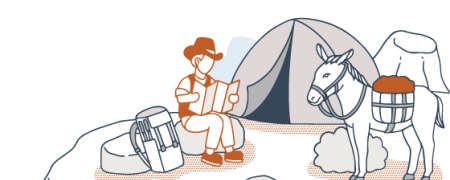Top 10 Unknown Grand Canyon Tourist Attractions

Published: February 18, 2020
Discover unknown canyon attraction's
If you're looking to get away from the crowded tourist stops every other Grand Canyon National Park visitor wants to see, explore the Guru’s comprehensive list of less visited (but still incredible!) locations and activities to plan your trip to the canyon. Just because they aren't as well-known doesn't mean they’re not amazing and our Top 10 Unknown Attractions list is sure to add some great variety to your trip.
Grand Canyon Guru is reader-supported. When you buy through links on our site, we may earn an affiliate commission. Thanks.
1. The North Rim
Most of Grand Canyon’s ~6 million annual visitors head to the South Rim because of its convenient location, comprehensive services, and world-famous overlooks. If you’d prefer a much quieter location without sacrificing the epic canyon views, head to the North Rim instead. Only open from May 15th through the first snow of the winter, the North Rim has it all: scenic drives along Cape Royal Road, easy hikes to scenic overlooks like Bright Angel Point, access to the inner canyon along the North Kaibab Trail, and even mule rides. If you visit later in fall, you’ll truly be able to get away from the hustle and bustle that is commonplace on the South Rim. The North Rim has beautiful meadows and aspen groves (perfect for fall colors!) and sweeping canyon views, giving you access to one of Grand Canyon’s best kept secrets.
2. Grand Canyon Fall Colors
Because of its high elevation (8,000ft+) the North Rim of Grand Canyon is home to beautiful groves of aspen trees. Providing great shade and pretty photos throughout the summer, the aspens turn into a true showstopper in the early fall as their leave become a vibrant yellow. Fall colors typically start in late September or early October so you should call the park rangers or the North Rim Lodge to check on timing if you’re making a special trip to see the canyon’s rim shrouded in yellow aspens. Once you’re there you can also take advantage of the quiet season and find a trail or overlook to yourself.
3. Winter at the South Rim
It’s usually warm and sunny at Grand Canyon, especially during the peak summer season, but there are other sides to this busy tourist destination. Winter is quiet and usually fairly mild, but huge snowstorms often blanket the South Rim and turn the park into a winter wonderland, if only for a little while. Timing is key to enjoying the snow though: arrive in the middle of a big storm and you won’t see a thing. Arrive in the first few hours after a storm, however, and you might get once in a lifetime photos of the canyon’s colorful rock layer dusted in white, sometimes all the way down to the bottom.
If you really want to explore Grand Canyon in the winter, consider a Christmas or New Year’s trip to the South Rim. The El Tovar Hotel provides cozy seasonal lodging and is decorated to the nines with a two-story tall Christmas tree and Santa hats on the stuffed animal heads that line the walls. Snuggle up next to the blazing fire in the restaurant’s fireplace while enjoying some gourmet food and drinks. A fun way to travel to the canyon in the winter (and avoid potentially treacherously icy roads) is to take the Grand Canyon Railway into Grand Canyon Village and if you have kids, they even offer a Polar Express trip to the North Pole twice a night as well.
4. Shoshone Point
While there are too many famous Grand Canyon overlooks to list, it is hard to find a truly quiet spot without sacrificing your view. Off the beaten path, Shoshone Point is located on the South Rim and is accessible via Desert View Drive (Hwy 64) and a pleasant walk through the forest. Because this overlook is not marked on most maps, you’ll generally see only a few people, if anyone at all. The trailhead is easiest to find if you’re driving from Grand Canyon Village towards Desert View and you’ll see an unmarked dirt parking area on the left side of the road just past mile marker 246. Walk around the locked gate and you’ll enjoy an easy 1-mile hike through the ponderosa pine forest before you arrive at the point. Walk to the left, past the picnic structures, to the rocky overlook that extends into the canyon to get a truly unforgettable canyon view. This is a great spot for more intimate sunrise or sunset.
5. Grand Canyon Fishing
Grand Canyon has some great fishing, and in particular fly fishing. You can bring your own fly rod or casting equipment on overnight hikes to the Colorado River, but you’ll also find good fishing in many of the side canyons as well such as Bright Angel Creek. If you’d prefer to skip the hike and have an expert take you out instead, you can hire one of many outfitters near Lee's Ferry along the East Rim who will take you upriver in a boat. Grand Canyon has both rainbow and brown trout near Lees Ferry and throughout the upper canyon. If you head further down river on a river trip, you'll begin to find striped bass and catfish that have been making their way up from Lake Mead due to the warming water.
6. Grand Canyon Star Party
Although most people come to Grand Canyon for the breathtaking daytime views of the largest canyon in the world, nighttime reveals an entirely different wonderland for you to enjoy. With its remote location, lack of artificial lights, and clean air, the national park has become a renowned night sky park and you will likely get better views of the stars above the canyon than you will ever see back home. To allow visitors to learn and explore more about the skies above, the national park hosts an annual Star Party on both rims of the canyon every year in June. For two weeks, amateur astronomers set up and share their impressive telescopes with you so you can get close-up views of distant stars, planets and galaxies. Stars are visible soon after sunset, but the best views come after 9pm when you’ll start to see the blanket of stars in the Milky Way stretch across the sky and park rangers offer guided night sky programs to reveal the wonders of the universe to you.
7. Grand Canyon Rock Art
Grand Canyon is the ancestral home to many native tribes whose ties to the park continue today. For 13,000 years native people have lived and hunted throughout Grand Canyon, all the while creating some incredible pictographs and petroglyphs. Although the locations of archaeological sites are not given to the public in order to better protect them, if you do a little exploring and you can find these links to the past. For an easy spot to view a pictograph panel, head a few minutes down the Bright Angel Trail through the first tunnel. Up on the cliff face to your left you’ll see a colorful hunting scene dating back 800 years.
8. Drive to the Colorado River through the Grand Canyon
Unless you hike to the bottom of Grand Canyon or go on a rafting trip, most people only get a glimpse of the Colorado River from afar as they gaze down from overlooks along the canyon’s rim. If you have some extra time to explore, though, there are other ways to touch the waters of the mighty Colorado, all from the comfort of your car. Lees Ferry at the eastern boundary of the park has a paved road right to the river where you can watch rafters load their boats for their trip through the canyon. If you have a 4X4 you can even drive through the canyon itself along Diamond Creek (on the Hualapai Indian Reservation) near Peach Springs, AZ right to the banks of the river. This remote location is a good spot to have a picnic and listen to the rushing water.
9. Grand View Lookout Tower
Although everyone has heard of the Desert View watchtower, not many people know that there is another nearby tower to climb for a view of Grand Canyon from above. Still an active fire lookout tower on the Kaibab National Forest, the Grandview Lookout Tower offers you a unique view of the canyon, with hardly anyone around too! As you drive east from Grandview Point to Desert View, follow signs on the right side of the road for the Arizona Trail/FR 310. A few minutes’ drive down a well-graded forest service road will take you to the base of the lookout tower. Outside of the summer months the tower is unstaffed but if you go there in the summer you’ll likely have the chance to talk to the fire spotters who can tell you about how their work and let you inside to take full advantage of the unusual view (if there aren’t any active fires in the area).
10. Phantom Ranch
At the bottom of the Grand Canyon, Phantom Ranch is a unique destination that is not a ranch at all, but a one-of-a-kind backcountry lodge. Only accessible via an overnight hike or mule ride to the bottom of the canyon, Phantom Ranch offers amazing luxury in one of the most remote hotel locations in the US. The ranch offers both shared dorm beds as well as private cabins, all of which must be reserved via the Phantom Ranch lottery 14 months in advance. The charming stone and wood cabins are nestled among the shady cottonwood trees and along the banks of Bright Angel Creek, a great place to swim on a hot canyon day. Despite hiking up to 14 miles to get there you’ll still enjoy hearty, hot meals and cold beers and treats. An easy 15-minute walk takes you to the banks of the Colorado River where you can watch river rafters floating through the canyon. A trip to Phantom Ranch is a once in a lifetime backcountry hotel experience where you can send a postcard to someone you love that says “Delivered by mule from Phantom Ranch.”



